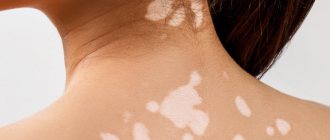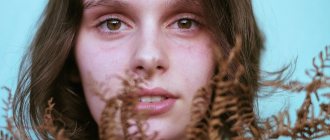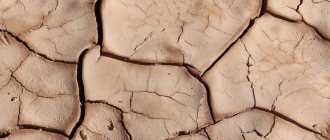Sometimes after sunbathing you may notice the appearance of white spots on the skin. Most people do not realize that this is a symptom of a skin disease.
At first, a person is bothered by itching and peeling of small areas of the skin, and after prolonged exposure to the sun, white spots appear on the arms, legs or chest. Most often, white spots on the skin are a sign that there is a fungal infection in the body. This is how pityriasis versicolor manifests itself.
When exposed to sunlight, healthy skin cells produce melanin, but the affected cells remain light-colored because they do not allow sunlight to pass through. Ringworm does not disappear on its own. At the first symptoms of tinea versicolor, you should consult a dermatologist.
What are the causes of pityriasis versicolor?
The causative agent of pityriasis versicolor is a conditionally pathogenic species of yeast that is constantly present on human skin and is part of its natural microflora.
The development of tinea versicolor occurs only under favorable conditions:
- genetic predisposition;
- increased sweating and changes in the chemical composition of sweat;
- frequent use of antibacterial gels;
- long-term treatment with steroid hormones;
- elevated blood sugar levels;
- weakened immunity;
- sun radiation (excessive tanning)
- diseases of the gastrointestinal tract, liver, pancreas;
- violations of skin barrier functions.
Most often, pityriasis versicolor occurs in young people, both men and women, but it also occurs in children with weak immunity, diabetes and vegetative neurosis. A separate risk group is children who experience excessive sweating during puberty. The likelihood of developing tinea versicolor is increased by solar radiation, heavy metals, and clothing made of synthetic materials.
What causes the appearance of white spots on the back?
Many causes of hypomelanosis have been identified. What do white spots on the back most often mean:
- There is very little melanin pigment in the body. Melanin protects our skin from environmental influences and when it is lacking after exposure to ultraviolet light, light spots form on the back and shoulders.
- Shingles. A skin disease in which the causative agent is a skin fungus, the infection is transmitted through contact with an infected person.
- The most common cause of spots is the disease vitiligo. If the sun has been exposed to the skin for a long time, then the melanin from the cells may slowly disappear, as a result, the white spot on the back, chest, lower back and shoulders does not tan and differs from healthy areas. This disease does not manifest itself in any way, only some patients noticed that before the spots on the body disappear there may be itching or irritation.
The reasons for the development of vitiligo can be:
- viral diseases and, as a result, impaired immunity.
- heredity;
- parasites in the body (worms), more common in children and adolescents.
For example, in children, the formation of vitiligo disease is often associated with the existence of intestinal dysbiosis and insufficiently developed pancreatic function.
Is tinea versicolor contagious?
Not all infected people develop clinical signs of tinea versicolor, which is why it is classified as a conditionally infectious disease. Ringworm is transmitted through clothing, towels, and bedding. Pityriasis versicolor does not threaten human life, but at its first manifestations you should consult a dermatologist. If you do not pay attention to the symptoms and manifestations of the disease and do not start treatment, the spots on the skin will remain for a long time.
During treatment you should not visit beaches, swimming pools and baths. Rehabilitation involves general and individual measures for the treatment and prevention of pityriasis versicolor, intended for patients and people who may come into contact with them.
General measures to prevent ringworm:
- carrying out disinfection with chlorine-containing substances in public places (swimming pools, baths, saunas, sports facilities, industrial enterprises, etc.);
- sanitary educational work.
Individual treatment measures for ringworm:
- hygienic skin care;
- boiling linen and towels, ironing them;
- treatment of chronic diseases that can cause the appearance of tinea versicolor;
- individual drug treatment prescribed by a dermatologist.
How to increase your chances of an even tan? Useful tips
Treatment of dermatological defects directly depends on the reasons that caused them. But what to do if everything is in order with your health, a medical examination did not reveal any abnormalities, and the flawless shade does not want to “lay down” on the skin? Try changing your approach to daily care and tanning sessions, and perhaps the color will be natural and uniform, and there will be no trace of white spots left:
- Main quality! Avoid cheap and untested skincare products. At best, it will be useless, at worst, it can harm the tanning dermis. It is better to buy 1-2, but high-quality creams or lotions that can provide the dermal cells with everything they need.
- Monitor your vitamin balance. Vitamin and mineral complexes included in cosmetics can intensively nourish the dermis, as a result of which it tans better and more actively. Ideally, the chosen cream will contain vitamins A and E, natural oils and plant extracts for deep nutrition of skin cells (the effect of vitamins on tanning).
The main thing for skin is care
- Maintain drinking regime. Dehydration affects not only the condition of internal organs, but also the sensitivity of the skin. Try to drink more fluids before and after sun exposure, and also avoid overly salty and smoked foods that retain water in the body - this way you can maintain a normal water-salt balance.
- Cleanse your skin in a timely manner. Dead skin flakes, clogged pores, sweat, sebum deposits and other impurities unevenly reduce the skin's sensitivity to ultraviolet light, which can lead to blemishes. Therefore, when going to the beach, take sanitary napkins with you to cleanse your skin, and also regularly use mild peels and detergents designed for delicate cleansing - this will help you prepare for the session and make your tan more durable.
- Maintain good hygiene. When visiting a solarium, make sure that the administrator treats the booth with a disinfectant after each client. Be sure to use disposable mats, paper footprints to protect your feet, and your own sunglasses - this way you will protect yourself from infectious skin diseases.
Reduce your tanning sessions
And most importantly, don’t overdo it! If, despite all efforts, the tan does not become uniform and deep, and the number and size of white spots increases, you should give up long sunbathing and sessions in the solarium - alas, in this case you will not be able to overcome the peculiarities of your skin.
Why shouldn’t pityriasis versicolor be treated with traditional methods?
Self-medication is dangerous to health; you should not prescribe medications to yourself or use traditional methods of treatment - this can worsen the condition of the skin and aggravate the development of the disease. Only a dermatologist can determine the exact type of infection and its nature and help choose treatment to eliminate the symptoms.
If you feel discomfort on the skin in the arms, legs or chest, you should consult a dermatologist. If you strictly follow the instructions, you will be convinced that the fungus on the skin can be treated.
What to do to prevent age spots from appearing
Prevention scheme:
Antioxidant preparations
Why we shouldn’t forget about the effects of free radicals: pigment cells also react to their excess by increasing melanin production.
Causes of excess free radicals:
- age over 30-35 years
- solar radiation
- bad ecology
- dietary violations, etc.
Residents of megacities and hot sunny regions experience a special load of free radicals, and therefore their own antioxidant defense system is depleted ahead of time and cannot cope.
Lightening agents
Starting in early spring, the use of agents that normalize and balance the work of melanocytes. These are non-aggressive lightening agents that do not thin the skin or increase sensitivity.
Example: DermaQuest SkinBright lightening line is designed specifically to work with pigmentation of any severity. Combined formulations and the absence of aggressive and dangerous ingredients make therapy not only effective, but also comfortable.
DermaQuest SkinBright serum and cream are a combination that enhances each other’s effectiveness. Advantages:
- rich composition of safe brightening ingredients
- do not require additional skin care products
- moisturize, nourish, have an antioxidant effect
- prevention of age-related changes
Contains:
- Stem cells of Lily Snow White
- Melanostatin-5 (brightening peptide)
- Chromebright
- Bakuchiol A (Vitimon A simulator without the irritating effects of retinoids)
- Hexylresorcinol – 4 times more active than hydroquinone in lightening effect
- Emblica – plant extract
- Kojic acid dipalmitate
- Bearberry, licorice root and white mulberry extract
- Arbutin
- SkinBright preparations do not contain Hydroquinone!
They do not have an irritating effect, have a moisturizing and nourishing effect, making them a complete treatment used morning and evening for the entire face.
There is no need for local application and the purchase of additional care products!
Vitiligo
The pathology affects people regardless of age, nationality and gender. The disease is rare, and the localization of the spots is not limited to the back. Lesions can appear on any part of the body except the palms and feet.
Reasons for development
Today, the exact causes of vitiligo have not been established. Doctors identify several factors predisposing to its development:
- liver dysfunctions,
- pathologies of the endocrine system,
- infection,
- excitement, stress.
Hereditary transmission of the disease to a child from parents is not excluded.
In a child, pathology often develops due to intestinal dysbiosis or pancreatic dysfunction. Among the rarer causes are parasitic diseases. After diagnosis, the doctor will be able to determine what allegedly caused vitiligo and direct therapy in the right direction.
pharmachologic effect
The medicinal substance has a pronounced antiseptic effect. This is a universal remedy in the fight against non-infectious and other dermatological diseases.
Thanks to its safe composition, it can be used by a wide range of people with different skin types. The active substance of the drug specifically acts to relieve the inflammatory process, providing an astringent, drying, adsorbent and decongestant effect.
In general, Tsindol has a positive effect on the skin and suppresses the active course of the pathological process. When applied to the skin, it forms salts, leading to denaturation of protein structures. The latter is extremely important for the treatment of rashes, pimples, burns and other formations, since film formation occurs. It has a protective function against the harmful effects of adverse factors.
Diagnosis and treatment
The cause of the rash is determined by a specialized doctor. As a rule, a visual examination first follows, then tests and additional examination are prescribed. It is useless to describe the rash in words or in correspondence - it is impossible to make a diagnosis in this way, just like on your own. Therefore, if “unhealthy” spots appear on the skin, you need to make an appointment with a dermatologist. If there is a suspicion of a skin pathology, it may additionally be recommended to take a scraping from the affected area for further examination.
Treatment of rashes should be under the guidance of a physician. His task is to prescribe effective and appropriate therapy. In cases of chickenpox, measles and rubella, there is no need to take a course of antibiotics.
If we are talking about a rash due to the presence of scabies mites, then the treatment will be simple. Rashes of an allergic nature require taking samples and prescribing treatment to eliminate the pathogen. Non-infectious skin diseases do not go away on their own; proper treatment is required, taking into account all the characteristics of the body.
Any spot of unknown origin on the body should be shown to a dermatologist if there is cause for concern. Do not voluntarily take medications not prescribed by a doctor. If treated incorrectly, there is a risk that the disease will worsen and then more serious treatment will be required, including hospitalization.
What is Tsindol
The drug Tsindol is classified as a dermatotropic. Sold in a dark glass bottle of 125 ml in a cardboard box with attached instructions. It is a colorless suspension with slight sediment for external use.
The active component of Tsindol is zinc oxide. It has antiseptic and anti-inflammatory properties. Dries and forms a protective barrier on the surface of the epidermis.
Excipients are:
- Ethyl alcohol – effectively copes with skin impurities, disinfects and disinfects.
- Glycerin – helps maintain water balance, nourishes and moisturizes.
- Starch.
- Talc is a medical product that removes excess sebum and reduces the formation of pustular processes.
- Distilled water.
Shelf life is up to 2 years in a cool and dark place, away from children.
Is it possible to cure pityriasis versicolor?
With proper therapy, pityriasis versicolor is easily treated and goes away within 2-3 weeks. To do this, you need to make an appointment with a dermatologist, who will conduct an examination and prescribe additional tests.
As a rule, the diagnosis is established in the presence of a typical clinical picture, but to confirm it, the following analyzes and tests are performed:
- examination under a Wood's lamp: fungal colonies are illuminated;
- microscopic examination of the scraping: shows the presence of yeast;
- Balzer test using iodine-containing solutions.
A dermatologist may also prescribe histological studies, general blood and urine tests. Based on the results of the examinations, treatment tactics are developed.
Depending on the severity and severity of the infection and the symptoms of lichen, therapy includes:
- the use of external agents (sprays, lotions, ointments) with antifungal components. If the scalp is affected, special shampoos are prescribed;
- antifungal drugs for internal use. Prescribed to patients prone to relapses of pityriasis versicolor, or to patients with atypical manifestations of infection.
If the patient suffers from severe itching (which is extremely rare), antihistamines may be prescribed.
How to apply Tsindol
The medicine is used externally. The previously desired surface of the skin is washed with water and dried. The suspension must be shaken until smooth. Afterwards, a small amount of the drug is applied to the problem area with a cotton swab and left for 3 hours. After time, wash off with warm water. The frequency of use is no more than 5 times a day.
The duration of treatment depends on the diagnosis and the extent of skin damage. As a rule, from 3-4 days to several weeks.
Directions for use for various dermatological conditions:
- Severe lesions - use the drug in the form of masks. It is applied to a certain area until it dries, after which the area is covered with a cloth, fixed and left overnight. After removal, the area is lubricated with moisturizer.
- For wounds and burns, it is recommended to apply a bandage with Tsindol. Changes as it dries.
- For children, apply to areas in constant contact with moisture. For diaper rash, the affected skin is treated with the medicine up to 3 times a day after changing the diaper. Before taking the ointment, it is recommended to wash the skin of newborns with a weak manganese solution.
- For dermatitis – suitable for the treatment and prevention of the disease. Eliminates hyperemia and itching as a result of fungal and bacterial infections. In therapy, use for 1-3 days, apply locally to the area, leave for 2-3 hours and wash off.
When working with the drug, it is necessary to avoid its contact with the mucous area.
Indications for use
The drug is effective against the following diseases:
- Bedsores.
- Eczema in the acute stage.
- Ulcers.
- Superficial disorders of the skin.
- Burns of various etiologies.
- Diaper rash.
- Inflammatory processes, including against the background of allergies.
- Herpes.
- Sweating.
Often, the ointment is used for dermatological complications, including the formation of pustular processes. Also active against acne, scars and teenage rashes.
How does Tsindol affect acne?
Tsindol is an excellent remedy for the treatment of acne in adolescence and adults. All thanks to the effective and natural composition.
Pimples are formed as a result of dysfunction of the sebaceous glands. And zinc oxide, an active ingredient, helps regulate their work. Dries and disinfects existing rashes. Whitens the skin and removes oily shine. Additional components enhance the therapeutic effect.
The drug can be used for treatment purposes not only in its pure form, but also can be used to prepare ointments, masks and special cleansers at home.
To eliminate acne, the suspension is applied to clean skin at night and washed off with water in the morning. The area of influence of the drug is extensive; it is allowed to treat the back, shoulders, face and décolleté.
For dry skin types, leave the ointment on the surface for no more than 3 hours and wash off with warm water.









